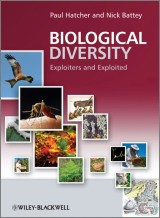Details

Biological Diversity
Exploiters and Exploited1. Aufl.
|
63,99 € |
|
| Verlag: | Wiley |
| Format: | EPUB |
| Veröffentl.: | 23.03.2011 |
| ISBN/EAN: | 9780470979860 |
| Sprache: | englisch |
| Anzahl Seiten: | 440 |
DRM-geschütztes eBook, Sie benötigen z.B. Adobe Digital Editions und eine Adobe ID zum Lesen.
Beschreibungen
<p><i>Biological Diversity</i> takes a fresh, innovative approach to the teaching of biodiversity. Rather than detailing and cataloguing the major taxa and their evolutionary relationships, the authors have selected 18 groups of organisms and used these as a framework in which to discuss the species and their interactions with man and each other. There is a strong narrative theme throughout – the exploited and the exploiters - and, in many cases, there is emphasis on the historical context. A wide range of organisms are covered, from the unicellular to birds and mammals and with an equal consideration of plants and animals. Species have been chosen for their ability to best illustrate particular biological principles, and for their strong interaction with other species.</p> <p>After an introduction the book is divided into two parts: 'Exploited' and 'Exploiters'. Each of the chapters, although linked to each other, forms a stand-alone essay. They are scientifically rigorous, up-to-date and do not shy away from addressing some controversial issues. Chapters have 'text boxes' highlighting important issues and concepts, lists of further reading and references. In addition to tables and figures the book has a selection of original illustrations drawn by leading artist Steven Appleby.</p> <p>This fresh approach will appeal to all those interested in the biological sciences, and aims to be accessible to people with a diversity of backgrounds. It will prove particularly useful to biology students, enabling them to get to grips with important biological principles and concepts that underpin the diversity of life, and the interrelationship of humans with other groups of organisms.</p>
Acknowledgements. <p>Chapter 1 Introduction.</p> <p><b>PART 1 EXPLOITED.</b></p> <p>Chapter 2 <i>Sargassum</i> and the Sargasso Sea.</p> <p>Chapter 3 Cephalopods.</p> <p>Chapter 4 The Honey Bee.</p> <p>Chapter 5 Sericulture: Silkworms and Mulberries.</p> <p>Chapter 6 Sugar Cane.</p> <p>Chapter 7 Legumes.</p> <p>Chapter 8 The Grapevine.</p> <p>Chapter 9 The Salmon.</p> <p>Chapter 10 Oak.</p> <p>Chapter 11 The Rabbit.</p> <p><b>PART 2 EXPLOITERS.</b></p> <p>Chapter 12 Malaria.</p> <p>Chapter 13 Biofouling and the Barnacle.</p> <p>Chapter 14 Bracken.</p> <p>Chapter 15 The Locust.</p> <p>Chapter 16 Plague.</p> <p>Chapter 17 The Red Kite.</p> <p>Chapter 18 Parasitic Plants: Mistletoes.</p> <p>Chapter 19 The Wolf.</p> <p>Index.</p>
<p>“Overall, this is a collection of papers that are realistic yet optimistic about the future and proposes positive solutions to the many problems of current fisheries.” (<i>The Quarterly Review of Biology</i><i>,</i> 1 March2013)</p> "In conclusion, this sizeable book is worth every page. It demands slow, steady reading. The writing style is very easy for even a non-science student to read and understand, especially those concerned with environmental conservation and protection. The figures are helpful with caricatures drawn to make the reading more fun. And the best thing about the book is that it satisfies all the related queries one may have about the topic, from its history to politics to biology to physics." (International Journal of Environmental Studies, 21 February 2012) <br /> <br /> "I cannot imagine anyone being disappointed by it, and feel it should find a place in the non-fiction best-seller lists." (Biodivers Conserv, 2011) <p>"Paul Hatcher and Nick Battey have clearly taken the significance of this role to heart, putting a great deal of thought into how to engage their target audience; namely under-graduates wishing to learn about their topic." (Taylor & Francis, 24 November 2011)</p> <p>"The figures are helpful with caricatures drawn to make the reading more fun. And the best thing about the book is that it satisfies all the related queries one may have about the topic, from its history to politics to biology to physics." (International Journal of Environmental Sciences, 1 February 2012)</p> <p>"This title is appropriate for undergraduate students in many disciplines, including biology. It will also be useful for readers interested in the ways human interact with other species. Summing Up: Recommended. All readership levels." (Choice, 1 November 2011)</p>
<b>Dr Paul Hatcher</b> and <b>Professor Nick Battey</b>, both at the School of Biological Sciences, University of Reading, UK
<i>Biological Diversity</i> takes a fresh, innovative approach to the teaching of biodiversity. Rather than detailing and cataloguing the major taxa and their evolutionary relationships, the authors have selected 18 groups of organisms and used these as a framework in which to discuss the species and their interactions with man and each other. There is a strong narrative theme throughout - the exploited and the exploiters - and, in many cases, there is emphasis on the historical context. A wide range of organisms are covered, from the unicellular to birds and mammals and with an equal consideration of plants and animals. Species have been chosen for their ability to best illustrate particular biological principles, and for their strong interaction with other species. <ul> <li> <div>An innovative, accessible, case-based introduction to biological diversity providing a balanced synthesis of science and history.</div> </li> <li> <div>Explores in-depth a selected range of organisms with equal coverage between plants and animals.</div> </li> <li> <div>Describes current and future methods for control and utilisation of troublesome and useful plants and animals.</div> </li> <li> <div>Clearly written and beautifully presented in full colour throughout, including some original illustrations by leading artist Steven Appleby.</div> </li> </ul> <p>This fresh approach will appeal to all those interested in the biological sciences, and aims to be accessible to people with a diversity of backgrounds. It will prove particularly useful to biology students, enabling them to get to grips with important biological principles and concepts that underpin the diversity of life, and the interrelationship of humans with other groups of organisms</p>

















